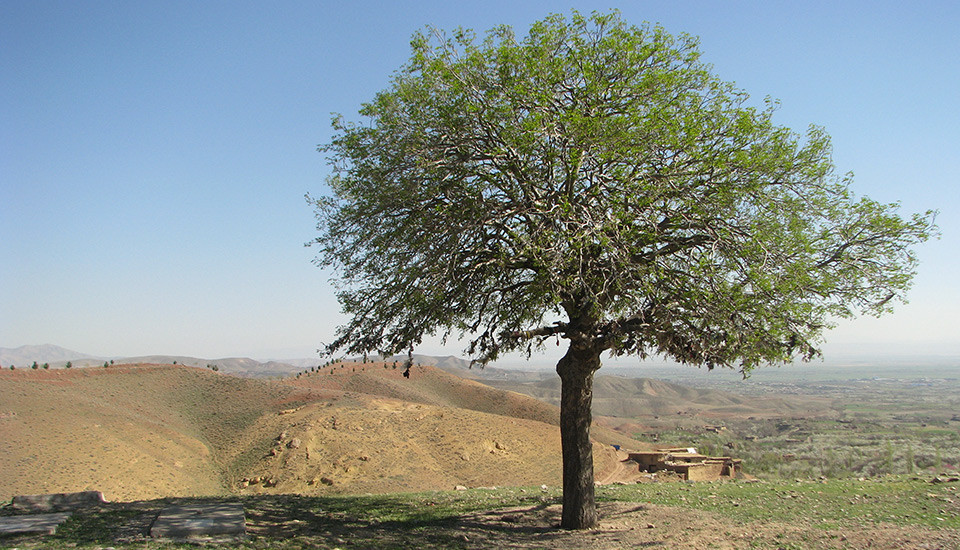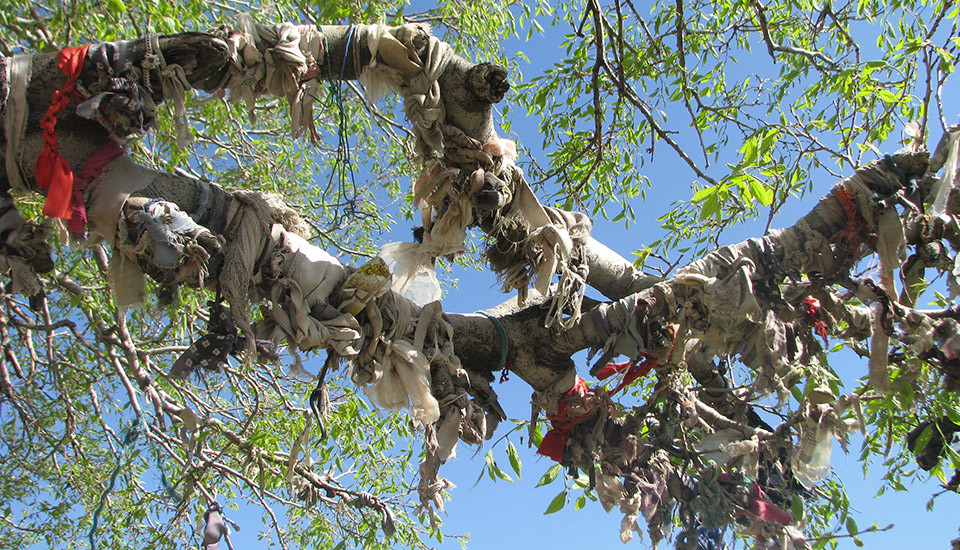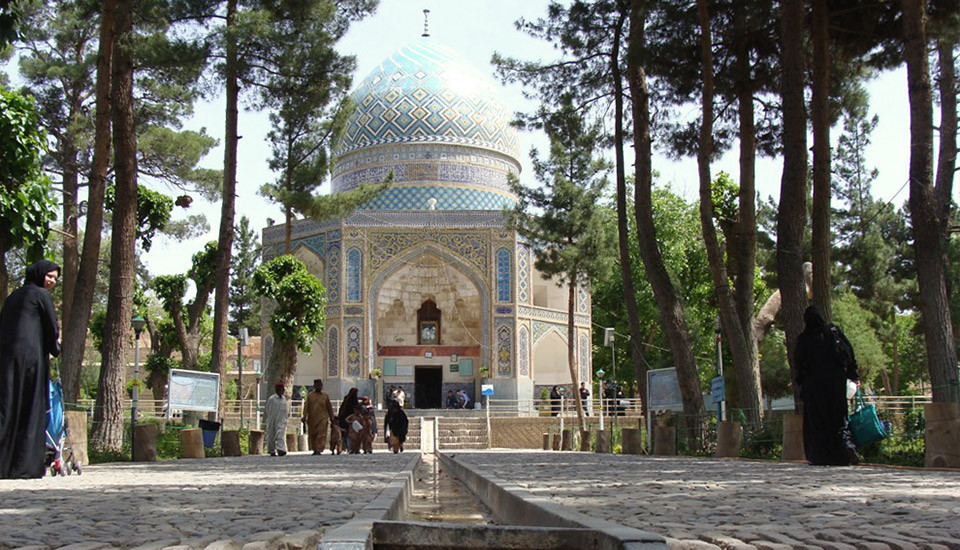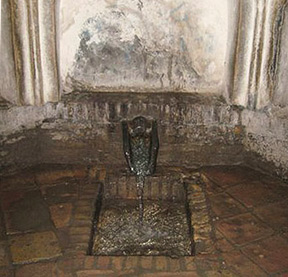Neyshabur és un municipi al nord-est de l'Iran. Una gran part d'ella es troba en una extensa plana envoltada de pujols i muntanyes. Hi ha diferents llocs sagrats naturals al municipi, que van des dels arbres sagrats i deus sagrats per un sagrat cant rodat i jardins sagrats. La zona alberga diverses plantes i animals endèmiques. It also contains protected areas and ecotourist destinations such as waterfalls, molls, rius i cridaners trets geogràfics com cims de les muntanyes. The climate is semi arid to dry with an average annual rainfall of 300 mm.
In spite of the fact that these sites are protected by local communities, their future is threatened by urbanisation, population growth, infrastructure development and tourism.
Protegit
Custodis
Els pobladors locals respectar les característiques naturals, ja que es basen en les seves creences religioses. Qadamgah a Neyshabur, per exemple,, és un jardí persa, on la natura s'ha imbuït dels valors espirituals. Conté una mansió, arbres, piscines i rierols. Una de les parets de la mansió conté una pedra negre en què dos empremtes d'haver estat tallat. La gent creu que aquestes petjades pertanyen a la vuitena Imam dels xiïtes, un líder espiritual mascle creu que és un descendent de Mahoma, divinament nomenat per guiar els éssers humans. La paraula significa Qadamgah empremta i es refereix a la narració.
Qadamgah’s history as a sacred site dates back to the pre-Islamic period. Though its original purpose is unknown, it is historically linked to the Sassanid prince Shahpour Kasra, as well as to Imam Ali and Imam Reza. Word goes that in 921 AD Imam Reza stopped at the garden on his way from Medina to Marv. The instant he wanted to perform his ablutions, a spring welled out of the earth. The spring has been regarded sacred ever since and people believe this water has healing properties.
Some plane trees (Plantanus sp.) have been actively conserved for centuries. Plane trees in Iran have been regarded as sacred for a long time because of the shade they offer, their largeness and their green appearance. All over Iran some plane trees have been kept alive for centuries. Legends and beliefs about some specimens have caused people to stay away from them. A long lived plane tree in a village of Neyshabur, per exemple, is conserved by local people because they believe that a man once lost his family due to the breaking of its branches.
Local people still conserve lesser-known sacred sites which have no legal protection. Els valors d'aquests llocs se'ls ensenya a les generacions més joves i les cerimònies religioses i les pràctiques es realitzen en comunitat, com ho han estat durant segles. D'aquesta manera, la pròxima generació aprengui a protegir.
Encara que no hi ha una estratègia formal de gestió, people tend to protect their sites. Some implement short term measures at a local level. Among a wide variety of plans that are carried out for example, a park has been established around a wish tree and tourist services have been developed there.
Acció
Local people and religious institutions continue their age-old practices. The local offices of Cultural Heritage, Handicrafts and Tourism register long-lived trees as national natural monuments. National natural monuments are relatively small, interesting, unique, exceptional, unconventional and irreplaceable phenomena of plant and animal collections having scientific, historical or natural significance. Protective measures in these areas guarantee their sustainable non-commercial use.
There is also a national plan for inventory and conservation of long lived trees under supervision of the boscos, Range and Watershed Management Organization of Iran. Recent research by Maryam Kabiri draws the attention to the significance of the spiritual values that these and other sacred sites have in relation to nature conservation.
Polítiques i Dret
La legislació iraniana no té cap menció dels llocs naturals sagrats fins ara. Alguns llocs naturals sagrats han estat oficialment conservat ja que es troben en àrees protegides o en un monument nacional. Altres han estat específicament registrats com monuments naturals nacionals. El Patrimoni Cultural i el departament de l'autoritat ambiental tenen alguna cosa a dir en la protecció de monument natural nacional. Advoquen principalment per flora i fauna o les formacions notables de la terra, paisatges o fins i tot arbres antics. Ells són llavors portats sota protecció mitjançant la designació d'un perímetre adequat.
Coalició
Some sacred sites in the area are under supervision of Endowments and Charity organizations (responsible for endowments and sacred places such as mosques and shrines) and a trustee board of local people. La Cultural Heritage, Handicrafts and Tourism Organization is responsible for registration and management of historical monuments and national natural monuments.
Qadamgah, per exemple, has been registered in this way, but it is also under supervision of endowments and charity organization of Iran and of the local trustee board. As in the case of Qadamgah, when a site has both cultural and spiritual values these organisations cooperate in the conservation and management of the site.
Eines de conservació
Criteria for conservation have been set up and these criteria have led to maps of areas in the township of Neyshabur which are in need of prioritized conservation. Some recommendations have additionally been formulated in this thesis, which may help with the initial steps for planning political agenda and developing criteria and indices of a national natural monument such that takes spiritual values into account.
Resultats
Sacred natural sites as a part of bio cultural diversity have been protected for centuries by local beliefs and values. Nowadays these sites are threatened for different reasons. If they are to survive, mesures actuals necessiten ser recolzats per la protecció legal. Per aquest propòsit, adopció d'un enfocament integrat basat en els criteris i polítiques conjuntes en els àmbits de la natura i la cultura pot jugar un paper clau en la conservació dels llocs naturals sagrats. Kabiri Hendi (2011) identificat com criteris per a la conservació dels llocs naturals sagrats al municipi de Neyshabur.
- Bahar, M. (1995) From myth to history. Cheshmeh Publication, Tehran, Iran.
- Daneshdoost, J. (1992) Persian Garden. Asar Journal, Vol.12: 48-52.
- Kabiri Hendi, M. (2011) The land evaluation for conservation of natural sites with spiritual values, a case study of Neyshabur Township. MSC thesis at Tehran University, Karaj, Iran.
- Taheri, A. (2009) Neyshabur Tourism Guide. Abarshahr, Mashhad, Iran.
- Pakdaman, B (2005) Qadamgah Garden Complex, Amagazine, issue7:86-93.







